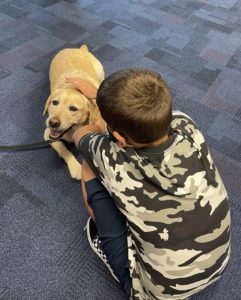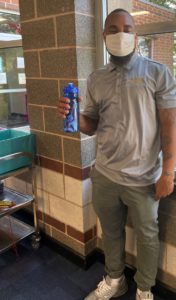One of the things Agatha Callahan noticed on the first day of school was how tall some of the kids had grown. After all, those who had remained fully remote during the COVID-19 pandemic hadn’t stepped foot in Villa Maria School for 18 months.

VMS’ rehabilitative facility dog, Carmen, greets a student on the first day of school.
“The first day energy – everyone was so excited. I heard so many kids running up to the staff and saying ‘I missed you so much!'” said Callahan, associate administrator and director of education at VMS. “And the staff were just as excited as the kids were to have the kids back.”
Coping through COVID
VMS provides educational and clinical services for children with significant emotional, behavioral and learning challenges. About a quarter of its student body lives at St. Vincent’s Villa, Catholic Charities’ residential treatment center for children ages 5 to 14. The other approximately 60 students arrive from four area school districts.
Like schools across the country, VMS shifted to online learning in March 2020 as the pandemic spread. Staff returned to the school full-time five months later, putting in place the protocols and practices needed for students’ safe return. Particularly because VMS children need more educational and clinical supports than other students, the school was anxious to resume in-person learning. But the continuing pandemic prevented children from returning until February. That’s when VMS launched a hybrid model, splitting the students into two cohorts, each of which could spend two days on campus and the rest learning remotely. That model lasted through the school’s summer session, which ended the first week of August.
Welcome back

Staff greeted students with water bottles filled with back-to-school goodies.
VMS staff spent a lot of time planning for students’ full-time return, recognizing that they might struggle to adjust to the structured routine. For example, staff expected some children would not be able to stay in the classroom throughout the day and might need to take a walk with a teaching assistant or visit with a therapist. Students seemed to adjust quickly over the first few days.
“The transition from hybrid to this has been much smoother than I anticipated,” Callahan said. “There’s trepidation, but we’re excited about being here.”
More than a year of virtual and hybrid learning will affect students in different ways, and VMS will closely watch the children and assess the need for any additional services or supports.
The school is also remaining vigilant about managing COVID and thinking through how best to support students if they cannot come to school because they have been exposed to the virus or need to quarantine.
“All the school systems are faced with the question of what to do,” Callahan said. “We’ll work with whatever the school system or family needs.”
